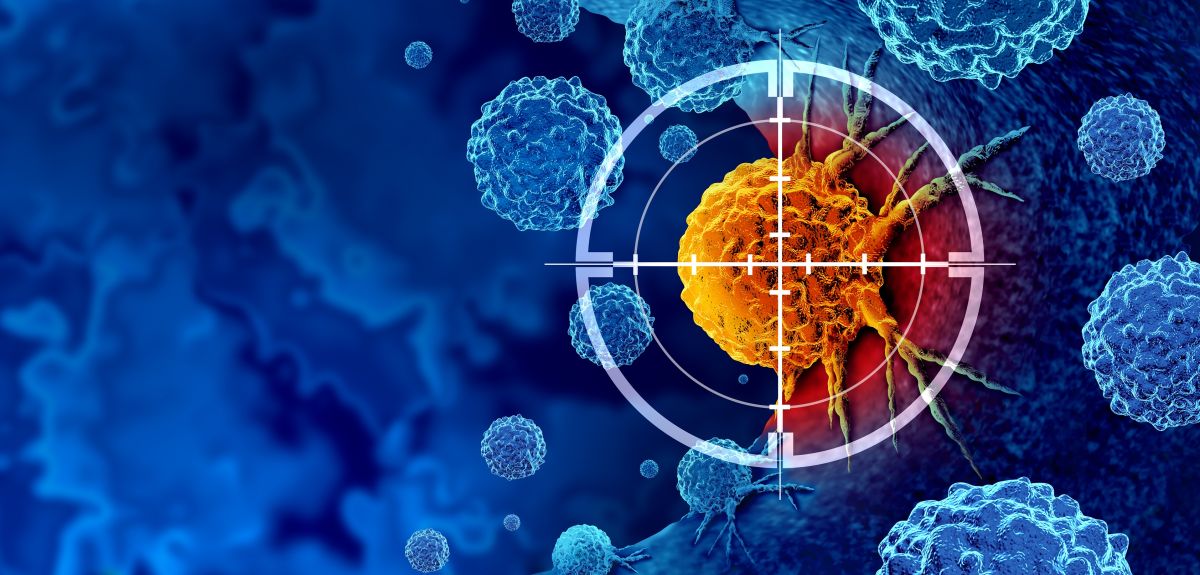
Image credit: Getty Images (wildpixel)
Researchers discover how immune cells hunt down cancer around the body
Scientists have discovered the key features of immune B cells which make them successful at targeting tumours - including when cancer has spread to a different part of the body.
Published in Nature Immunology, the researchers have developed a computational tool to identify these anti-cancer immune cells which could lead to improved, personalised immunotherapies. Most immunotherapies only work for a minority of patients – researchers are urgently working to expand the group of patients who could benefit from them.
Scientists at the University of Oxford’s Department of Biochemistry, the Institute of Cancer Research, London, and the University of Cambridge, took biopsies from patients with breast cancer and used a technique called B cell receptor sequencing to identify genetic variations in the B cells.
B cells, like the more broadly understood T cells, are part of the immune system, helping the body to fight infections as well as cancer. They produce proteins called antibodies which stick to harmful substances like viruses and cancer, and recruit other parts of the immune system to destroy them. When a receptor on the B cell identifies a cancer cell and binds to it, the B cell undergoes changes and diversifies to be even more effective at targeting those cancer cells.
Associate Professor Rachael Bashford-Rogers, lead author on the study and Associate Professor at the Department of Biochemistry at The University of Oxford, said: ‘Using a combination of different genetic methods, we showed that both B cell and T cell immune responses appear to co-evolve with the changes that occur in individual tumour sites within the body. However, some B cell responses were seen across many or all tumour sites, suggesting that they are seeking out cancer cells at different sites. Here we identified a common and predictable pattern of immune cell surveillance between multiple tumour sites and developed a tool to accurately identify these cells. We show that this is also generalisable to other disease settings including in autoimmunity, and so this work lays a foundation for prioritising specific antibody treatments in cancer and beyond.’
The researchers discovered that some unique B cells which had diversified their genetic sequence - after identifying and targeting cancer cells - were present at multiple metastatic tumour sites, where the cancer had spread to. This means that, after recognising cancer in one area of the body, B cells migrate to hunt down cancer at different sites around the body. B cells which were only found in one tumour site were less likely to have diversified and did not perform effective cancer surveillance.
Similarly, they found that B cells which were consistently present throughout patients’ treatment were those which had recognised cancer and had changed their genetic sequence, diversifying themselves to become more effective at identifying cancer.
The researchers then used this information to develop a computational tool to predict which B cells were most likely to successfully detect and target cancer cells.
They believe that, using their predictive tool, it will be possible to find a patient’s most successful anti-cancer B cells and artificially develop the antibodies that these B cells would naturally create. This could be given as a personalised immunotherapy treatment – supercharging the patient’s immune system.
Dr Stephen-John Sammut, first author on the study and Leader of the Cancer Dynamics Group at The Institute of Cancer Research, London, and Consultant Medical Oncologist at The Royal Marsden NHS Foundation Trust, said: ‘Once cancer spreads to other parts of the body, it’s often much more difficult to treat. Our research has revealed that the immune response to cancer isn’t limited to the site where a tumour initially appears – if an immune B cell is successful at detecting cancer in one part of the body, it will search for similar cancer cells elsewhere in the body.
‘Currently there are very few immunotherapies that can be used to treat breast cancer. The computational tool we have developed will allow us to zoom in and identify the B cells that have recognised cancer cells, as well as the antibodies they are producing. This will allow us to develop anticancer antibody treatments similar to the ones the B cells produce, which can then be given as a personalised treatment to boost the immune system’s response against breast cancer that has spread.’
Professor Kristian Helin, Chief Executive of The Institute of Cancer Research, London, said: ‘Immunotherapies have transformed the outlook for a range of different cancers but unfortunately, they still only work for a minority of patients. We need a greater understanding of how the immune system defends the body against cancer and most research has, until now, focused on the role of T cells – with CAR-T cell therapy being the best-known treatment to come from that research.
‘This study provides a fascinating insight into the role of B cells over the course of a cancer’s growth and spread, and I look forward to seeing this tool used to focus efforts for the development of personalised cancer immunotherapies which could work in far more people than most existing immunotherapies.’
The paper 'Predictability of B cell clonal persistence and immunosurveillance in breast cancer' is published in Nature Immunology.
 First proof that “plunging regions” exist around black holes in space
First proof that “plunging regions” exist around black holes in space
 University of Oxford to lead new Sustainable Chemicals and Materials Manufacturing Research Hub
University of Oxford to lead new Sustainable Chemicals and Materials Manufacturing Research Hub
 Nine Oxford scientists elected as Royal Society Fellows
Nine Oxford scientists elected as Royal Society Fellows
 Ruskin School of Art appoints new Associate Professors
Ruskin School of Art appoints new Associate Professors
 Internet use statistically associated with higher wellbeing, finds new global Oxford study
Internet use statistically associated with higher wellbeing, finds new global Oxford study